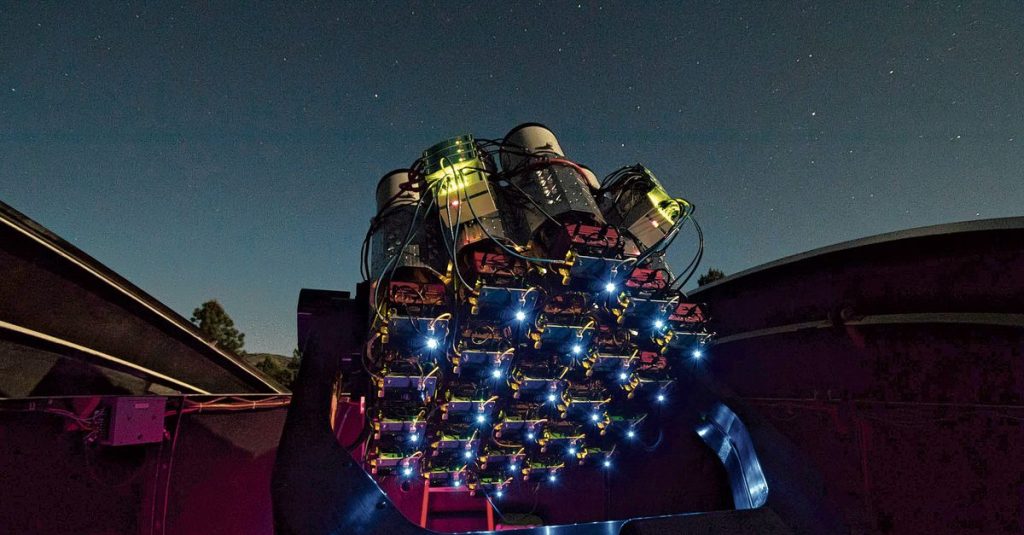Astronomers have found an explanation for two galaxies that contain almost no dark matter, a mystery that has puzzled astronomers for years. Using a homemade telescope, Dutch astronomer Peter van Dokkum discovered two galaxies in 2018 and 2019 that contain almost no dark matter. Now, simulations by the same team show that dark matter is missing there, because the ancient galaxies from which they were formed collided eight billion years ago. The dark matter separated from the gas, and new galaxies appeared without dark matter from this gas. the team published results Wednesday in the magazine temper nature†
Dark matter has not been seen, smelled, or heard. Its existence comes from calculations of rotational speeds in the universe. Galaxies rotate so fast that astronomers expect them to wobble apart. There isn’t enough mass in the galaxy to generate the gravity needed to hold them together. For this, a hypothetical matter, dark matter, was created, which generates the necessary gravity. The popular idea was that galaxies could only form with dark matter.
but df2 galaxies, Van Dokkum’s team found it, a professor at Yale University in the US, contains hardly any dark matter. The galaxy rotates so slowly that it doesn’t need dark matter to hold it together. DF2 is about 65 million light-years away and orbits the larger galaxy NGC 1052. Van Dokkum found the galaxy with Dragonfly, a telescope with 48 lenses he made with a Canadian colleague.
A year later, van Dokkum’s team found another galaxy without dark matter. This was DF4, which is also orbiting NGC 1052.
Gas-rich galaxies
Contrary to popular belief, how could galaxies form without dark matter? In 2019, astronomer Joseph Silk suggested that this galaxy is the result of the collision of two gas-rich galaxies. In the young universe, galaxies were mainly composed of dark matter and gases. When such systems collide, everything inside them vibrates. Dark matter and any stars pass each other and eventually drift outward. But the gas is compressed and therefore floats more slowly. Thus, the gas is separated from the dark matter. New stars are made of gas and eventually a new galaxy, without dark matter.
Van Dokkum model simulations now confirm that DF2 and DF4 may have arisen in this way. Van Dokkum: „We’ve looked at the current motions and velocities at which DF2 and DF4 are moving apart from each other and got them back in time. These motions are consistent with simulated motions of galaxies that formed from the collision of other galaxies, about eight billion years ago. “
It must have been a violent collision. Only when galaxies collide at at least 300 kilometers per second will the collision be severe enough to separate the dark matter from the gas. High impact speed compatible with notes. DF2 and DF4 are still moving away from each other at a fast pace, 358 kilometers per second.
“Surprisingly, we also found a row of six other galaxies in the same line as DF2 and DF4, possibly also devoid of dark matter,” says the astronomer.
Oddly enough, galaxies without dark matter provide evidence for the existence of dark matter. Van Dokkum: Some scientists suggest that dark matter does not exist. They don’t think that extra mass is needed to explain the amount of gravity, but they argue that gravity itself works differently than we think. But if the laws of gravity were really different, you’d expect this to be true for every galaxy. You cannot rule out the laws of physics in one place and not in another.”
A version of this article also appeared in the May 19, 2022 newspaper

“Total coffee specialist. Hardcore reader. Incurable music scholar. Web guru. Freelance troublemaker. Problem solver. Travel trailblazer.”







More Stories
OncoZON is the first European oncology network to receive the OECI Quality Mark
The first Irish satellite to go into space
This startup wants to deliver anywhere in the world within an hour from space